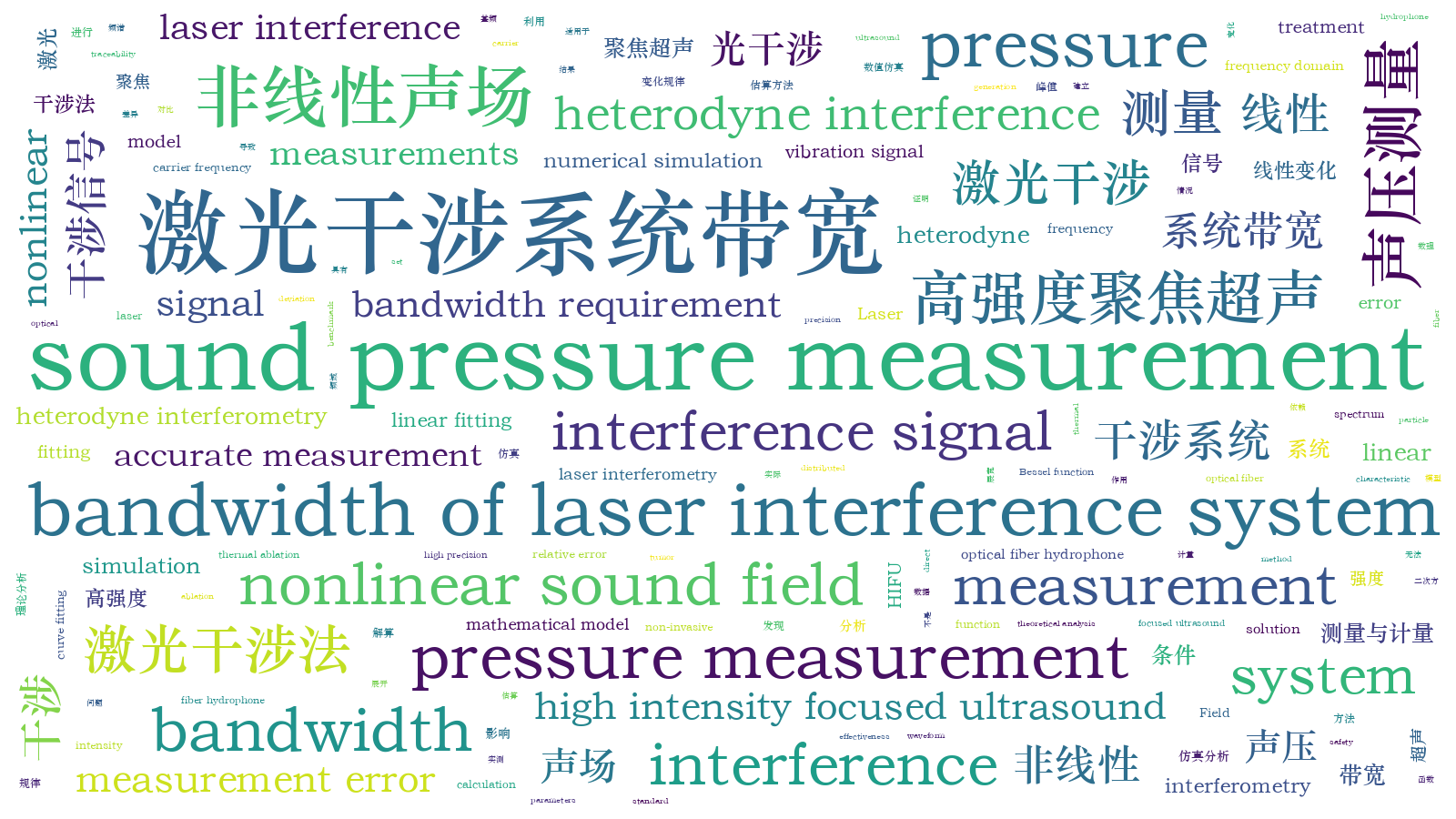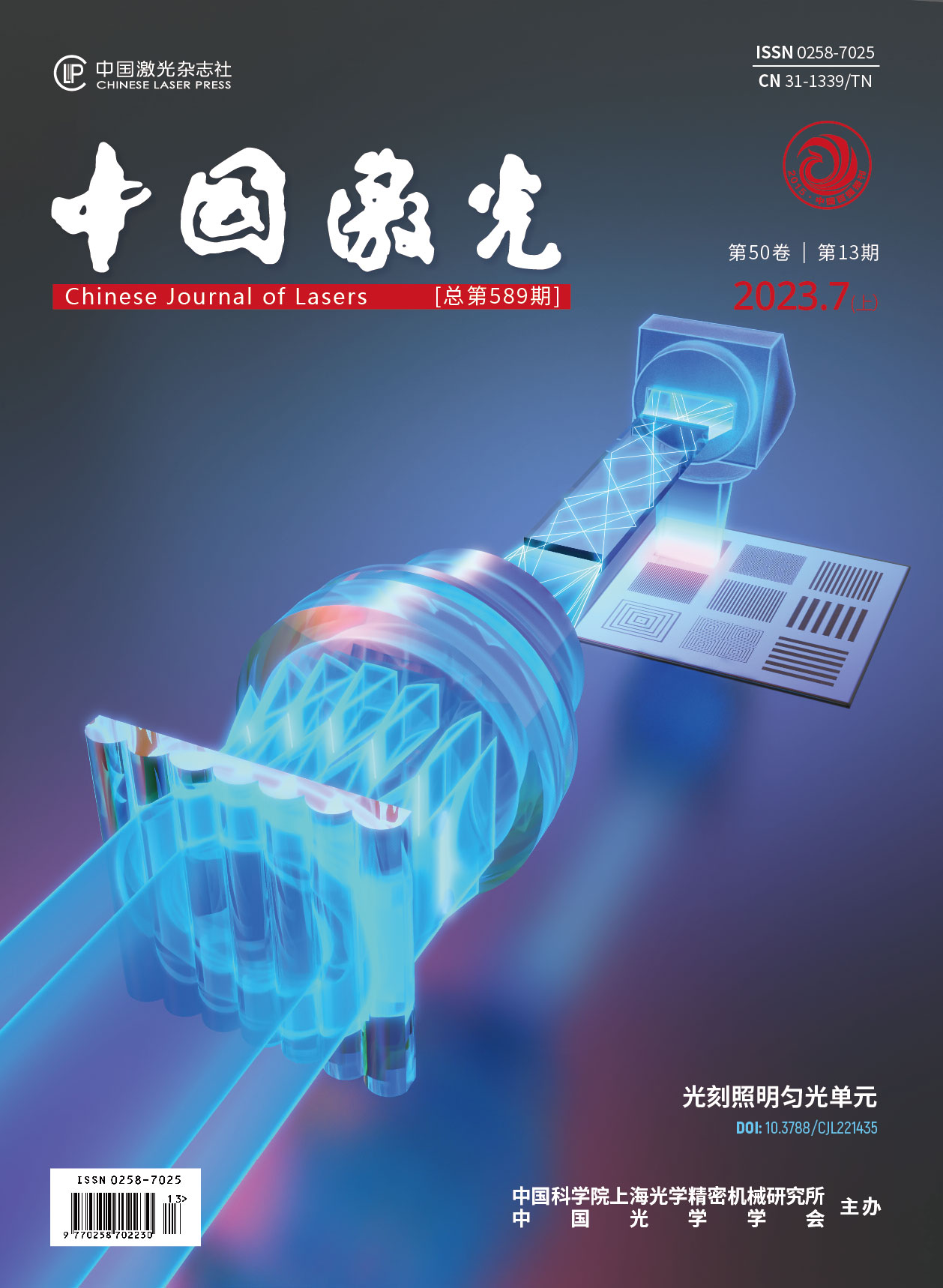高强度聚焦超声声压测量中非线性声场对激光干涉系统带宽的影响
High-intensity focused ultrasound (HIFU) is a non-invasive medical thermal ablation technology that can realize the “non-invasive” treatment of diseases. It is developing into a standard tumor treatment method. The accurate measurement of the HIFU sound pressure is very important for formulating clinical schemes involving HIFU treatment and ensuring the safety and effectiveness of the treatment. Laser interferometry has been adopted by new-generation sound pressure benchmarks because of its high precision, non-contact characteristic, and direct traceability to the length benchmark. The bandwidth of a laser interference system directly affects the upper limit of sound pressure measurements. Current methods of estimating system bandwidth are based on linear sound field conditions; however, with an increase in the measured sound pressure, the HIFU field will become nonlinear, leading to a deviation between the system bandwidth requirements and the model solution results. Aiming to address the problem of bandwidth calculation of interference systems for HIFU sound pressure measurement, this study theoretically analyzes a mathematical model of interference system bandwidth and vibration signal in HIFU sound pressure measurement, refers to the measured sound pressure value, and establishes the relationship between interference system bandwidth and sound pressure by numerical simulation.
According to the mathematical relationship between sound particle vibration and interference signal, a bandwidth model of interference signals under the condition of a nonlinear sound field is established. Because the interference signal is expressed as a nonelementary function that cannot be expanded by the Bessel function, the bandwidth of the interference signal under the condition of a nonlinear sound field is analyzed by numerical simulation. The simulation results show that compared with that in a linear sound field, the interference signal spectrum in a nonlinear sound field is not symmetrically distributed centered on the carrier frequency but widened and shifted. In order to obtain the real HIFU sound pressure and ensure that the simulation results are closer to the actual values, the HIFU sound field is measured using the optical fiber hydrophone, and the sound pressure waveforms and frequency domain distributions corresponding to different sound pressures are obtained. According to the waveform parameters of the sound pressure, the simulation conditions of the interference signal bandwidth are set, and the bandwidths of the interference systems required by different sound pressures are obtained.
Using the measured sound pressure data of the HIFU sound field, the relationship between the bandwidth of the heterodyne interference system and HIFU sound pressure is simulated. Under the condition that the relative error of the sound pressure measurement caused by the system bandwidth is less than 2%, the corresponding relationship between the lowest bandwidth of the heterodyne interference system and the peak value of the measured sound pressure is determined. Through curve fitting, it is deduced that quadratic fitting has a smaller fitting error than linear fitting. Therefore, it is inferred that under the condition of a nonlinear sound field, the bandwidth requirement of the heterodyne interferometry system changes via a quadratic law with the peak-to-peak of the measured sound pressure, which means that the bandwidth requirement of the heterodyne interferometry system will increase sharply with a higher intensity sound pressure measurement. When the peak value of the measured HIFU sound pressure reaches 60 MPa, the bandwidth of the heterodyne interferometry system should not be less than 473 MHz; thus, the sound pressure measurement error introduced by the system bandwidth can be less than 2%. Here, if the calculation is carried out according to linear sound field conditions, the system bandwidth in the same case is not less than 130 MHz, which obviously differs considerably from the actual situation and causes a large measurement error.
This study focuses on the problem that the bandwidth solution of the interference system in HIFU sound pressure measurement by laser interferometry depends on the linear sound field conditions, which causes a large difference between the solution results and reality. First, through theoretical analysis, a mathematical model of the interference signal for HIFU sound pressure measurement is established. The frequency domain of the interference signal is analyzed by numerical simulation. It is inferred that the spectrum of the interference signal under the condition of a nonlinear sound field is widened and shifted compared with that under the condition of a linear sound field. It is proved that existing methods for estimating the interference system bandwidth under the condition of a linear sound field are not suitable for HIFU sound pressure measurements. Combined with the HIFU sound pressure measurement data, the relationship between the bandwidth requirements of the heterodyne interference system and the peak value of the sound pressure is simulated and analyzed. The analysis results show that under the condition of a nonlinear sound field, the bandwidth requirements of the heterodyne interference system change via a quadratic law with the peak-to-peak value of the sound pressure.
1 引言
高强度聚焦超声(HIFU)治疗是一种非侵入性的医疗热消融技术,高强度聚焦超声束穿过软组织,在聚焦区域快速产生高温,使得病变靶区组织凝固坏死,从而实现疾病的“无创”治疗,该技术正发展成为标准肿瘤治疗方法的选择之一[1]。HIFU声压的精准计量对于制定HIFU治疗临床方案及保障治疗安全性和有效性至关重要[2-3]。激光干涉法凭借其高精度、非接触、可直接溯源至长度基准[4-5]等优势,被新一代水声声压基准所采用[6-9]。激光干涉法利用与声轴方向垂直的透声反光薄膜获取声场中水介质的振动信息,当薄膜厚度远小于声波波长时,认为薄膜跟随周围水介质振动。激光干涉系统测得薄膜上某一点的振动位移,再根据质点位移与声压的数理关系即可得到该点处的声压。
激光干涉系统的带宽大小直接影响了声压测量的上限。在激光干涉位移测量领域,通常用多普勒频移描述被测对象对干涉系统的带宽要求,在位移方向不变的情况下,系统带宽大于最大多普勒频移即可满足测量要求。在超声振动测量领域,由于质点振动速度的大小和方向变化迅速,多普勒频移随时间变化的影响不可忽略,最大多普勒频移与系统带宽的对应关系不再成立。在线性声场中,质点振动近似为简谐振动形式,对应的干涉信号为
为了描述上述声压大小与激光干涉系统带宽的关系,Barrière等[10-11]对线性声场作用下的干涉信号进行第一类贝塞尔函数展开,发现质点振动信号在干涉信号频域得到展宽,出现了振动频率的多次谐波,其对应的幅值系数为各阶贝塞尔函数
上述模型基于线性声场条件,但是随着被测声压的增加,高强度聚焦超声场会出现非线性,质点振动将不再是简谐振动的形式,这就造成了系统带宽与模型解算结果的偏差。因此,在基于激光干涉法的HIFU声压测量中,仍存在干涉系统带宽解算方法尚不完善的问题。
本文针对HIFU声压测量中干涉系统带宽解算问题,通过理论分析HIFU声压测量中干涉系统带宽与振动信号的数理模型并参考实测声压值,利用数值仿真得到干涉系统带宽与声压的关系。
2 HIFU声压测量中激光干涉系统带宽分析
激光干涉系统的光谱带宽可根据多普勒效应,通过被测振速与光频率的关系计算得到,光谱带宽的计算与被测振动的形式无关,且不是限制系统带宽的主要因素,因此该部分不展开论述。本文所指的激光干涉系统带宽主要是光电转换之后的电信号处理部分的带宽,该部分带宽受到被测振动形式即声场非线性的影响,是本文分析的重点。
2.1 HIFU声压测量中的激光干涉信号
基于激光干涉法的HIFU声压测量装置如

图 1. 基于激光干涉法的HIFU声压测量装置
Fig. 1. HIFU sound pressure measuring device based on laser interferometry
以二细分的零差干涉光路为例进行分析,干涉信号
式中:
在线性声场条件下,声压大小即薄膜振动随时间呈正弦规律变化,
式中:
因此可以得到贝塞尔函数展开形式为
由此可见,零差干涉信号的频谱包含振动频率
同理,外差干涉信号可以表示为
式中:
分析
HIFU声场在高声压下产生非线性效应,声压随时间的变化曲线出现丰富的多次谐波。振动位移
式中:
此时,干涉信号无法使用贝塞尔函数展开,且无法直接通过函数展开的方法对其进行频域分析。因此利用数值仿真的方法,对非线性声场条件下的干涉信号带宽进行分析。
2.2 非线性声场条件下激光干涉信号带宽的分析
使用数值仿真软件MATLAB对外差干涉信号带宽进行仿真分析,对比线性声场和非线性声场条件下外差干涉信号带宽的差异。仿真参数设置如下:外差干涉系统的载波频率

图 2. 线性声场和非线性声场条件下不同干涉信号的频谱
Fig. 2. Spectra of different interference signals under linear and nonlinear sound fields
定义外差干涉信号带宽
此时可以认为干涉信号中的有用信息不会丢失,系统不会由于带宽不足而引入测量误差。
在非线性声场条件下,假设薄膜振动包含基频至六次谐波分量,各谐波分量振幅之比为1.00∶0.40∶0.20∶0.10∶0.05∶0.02,且初始相位
在上述非线性声场条件的基础上,改变各谐波分量的初始相位,使得
为了获取真实的HIFU声压,使仿真结果更接近实际,本文利用光纤水听器对HIFU声场进行测量,HIFU换能器的激励频率设置为1 MHz。实验测得声压随时间的变化曲线如

图 4. 光纤水听器测得的HIFU声压。(a)时域波形图;(b)频域波形图
Fig. 4. HIFU sound pressure measured by optical fiber hydrophone. (a) Time domain waveform; (b) frequency domain waveform
根据上述实验获取声压各次谐波的参数,设置外差干涉系统带宽仿真条件,并忽略振动位移中三十次以上的谐波分量。同时,作为对比,对具有相同声压峰峰值的线性声场的情况进行仿真。仿真结果如

图 5. 线性声场和非线性声场条件下干涉信号带宽仿真结果。(a)线性声场频谱;(b)非线性声场频谱;(c)
Fig. 5. Simulation results of interference signal bandwidths under linear and nonlinear sound fields. (a) Spectrum under linear sound field; (b) spectrum under nonlinear sound field; (c)
2.3 激光外差干涉系统带宽与被测声压大小的关系分析
理想情况下外差干涉系统为全通系统,系统带宽

图 6. 外差干涉系统带宽变化对干涉信号和声压测量结果的影响。(a)干涉信号时域曲线;(b)干涉信号频域曲线;(c)测量得到的声压曲线
Fig. 6. Influence of bandwidth variation of heterodyne interference system on interference signal and sound pressure measurement result. (a) Time domain curve of interference signal; (b) frequency domain curve of interference signal; (c) measured sound pressure curves
由
进一步,通过改变外差干涉系统带宽

图 7. 声压测量相对误差随外差干涉系统带宽的变化曲线。(a)非线性声场;(b)线性声场
Fig. 7. Relative error of sound pressure measurement versus bandwidth of heterodyne interference system. (a) Nonlinear sound field; (b) linear sound field
同理,将声压参数设置为
利用光纤水听器测得的多组HIFU声场声压数据,对外差干涉系统带宽
式中:

图 8. 外差干涉系统带宽随被测声压峰峰值的变化曲线。(a)声压测量的相对误差小于2%时;(b)非线性声场下不同相对误差要求的二次拟合曲线
Fig. 8. Bandwidth of heterodyne interference system versus peak-to-peak value of measured sound pressure. (a) When relative error of sound pressure is less than 2%; (b) quadratic fitting curves with different relative error requirements under nonlinear sound field
同理,当外差干涉系统带宽引起的声压测量相对误差小于1%和5%时,在非线性声场条件下,外差干涉系统带宽随被测声压峰峰值变化的二次拟合曲线如
综合上述仿真分析可知,在线性声场条件下,外差干涉系统带宽随被测声压峰峰值呈线性规律变化,这与以往的研究结论是相符的;在非线性声场条件下,外差干涉系统带宽则随被测声压峰峰值呈二次方规律变化,这就意味着更高强度的声压测量对外差干涉测量系统带宽的要求激增。按此规律推论,当被测HIFU声压峰峰值达到60 MPa时,外差干涉测量系统的带宽应不小于473 MHz,这样才能使系统带宽引入的声压测量误差小于2%;若按照线性声场条件进行计算,同等情况下的系统带宽不小于130 MHz即可满足要求,这显然与实际情况相差较大。
以上分析以外差干涉系统为例进行展开,由于零差干涉系统可以认为是光学载波频率为0的一种特殊的外差干涉系统,其干涉信号的频谱分量以0为起点向正方向延伸,零差干涉系统实际可近似为低通系统,因此零差干涉系统在带宽上的要求约为外差干涉系统的一半,本文不再详细展开。
3 结论
首先通过理论分析,建立了HIFU声压测量中干涉信号的数理模型;针对非线性声场条件下干涉信号无法进行函数展开的情况,通过数值仿真的方法对干涉信号的频域进行分析;通过对具有相同声压峰峰值和基频的线性和非线性两类声场条件下的干涉信号频谱进行分析,发现非线性声场条件下干涉信号频谱相比于线性声场有不同程度的展宽和平移,证明了现有线性声场条件下干涉系统带宽的估算方法不适用于HIFU声压测量。结合实测HIFU声场声压数据,对外差干涉系统带宽与声压峰峰值之间的关系进行了仿真分析,分析结果表明:在非线性声场条件下,外差干涉系统带宽随着被测声压峰峰值呈二次方规律变化。研究结果为激光干涉法HIFU声场测量系统的带宽设计提供了理论指导和设计依据。
[1] Izadifar Z, Izadifar Z, Chapman D, et al. An introduction to high intensity focused ultrasound: systematic review on principles, devices, and clinical applications[J]. Journal of Clinical Medicine, 2020, 9(2): 460.
[2] Martin E, Treeby B. Investigation of the repeatability and reproducibility of hydrophone measurements of medical ultrasound fields[J]. The Journal of the Acoustical Society of America, 2019, 145(3): 1270-1282.
[3] Rajagopal S, Sainsbury T, Treeby B E, et al. Laser generated ultrasound sources using carbon-polymer nanocomposites for high frequency metrology[J]. Journal of the Acoustical, 2018, 144(2): 584-597.
[4] Koukoulas T, Robinson S, Rajagopal S, et al. A comparison between heterodyne and homodyne interferometry to realise the SI unit of acoustic pressure in water[J]. Metrologia, 2016, 53(2): 891-898.
[5] Xing G Z, Wilkens V, Yang P. Review of field characterization techniques for high intensity therapeutic ultrasound[J]. Metrologia, 2021, 58(2): 022001.
[6] Matsuda Y, Yoshioka M, Uchida T. Absolute hydrophone calibration to 40 MHz using ultrasonic far-field[J]. Materials Transactions, 2014, 55(7): 1030-1033.
[7] WangM, KoukoulasT, et al. Measurement of underwater acoustic pressures in the frequency range 25 to 500 kHz using optical interferometry and discussion on associated uncertainties[C]∥25th International Congress on Sound and Vibration, July 8-12, 2018, Hiroshima, Japan. [S.l.: s.n.], 2018.
[8] Feng X J, Yang P, He L B, et al. Influence of the frequency response of the photodetector on the heterodyne interferometer-based sound pressure standards in water[J]. Applied Optics, 2018, 57(32): 9635-9642.
[9] Theobald P D, Robinson S P, Thompson A D, et al. Technique for the calibration of hydrophones in the frequency range 10 to 600 kHz using a heterodyne interferometer and an acoustically compliant membrane[J]. The Journal of the Acoustical Society of America, 2005, 118(5): 3110-3116.
[10] Barrière C, Royer D. Optical measurement of large transient mechanical displacements[J]. Applied Physics Letters, 2001, 79(6): 878-880.
[11] JacobX, BarriereC, TakatsuR, et al. Optical measurement of transient ultrasonic shock waves[C]∥IEEE Ultrasonics Symposium, August 23-27, 2004, Montreal, QC, Canada. New York: IEEE Press, 2004: 52-55.
Article Outline
王珂, 杨平, 邢广振. 高强度聚焦超声声压测量中非线性声场对激光干涉系统带宽的影响[J]. 中国激光, 2023, 50(13): 1304002. Ke Wang, Ping Yang, Guangzhen Xing. Influence of Nonlinear Sound Field on Bandwidth of Laser Interferometry Systems in High‑Intensity Focused Ultrasound Pressure Measurements[J]. Chinese Journal of Lasers, 2023, 50(13): 1304002.







